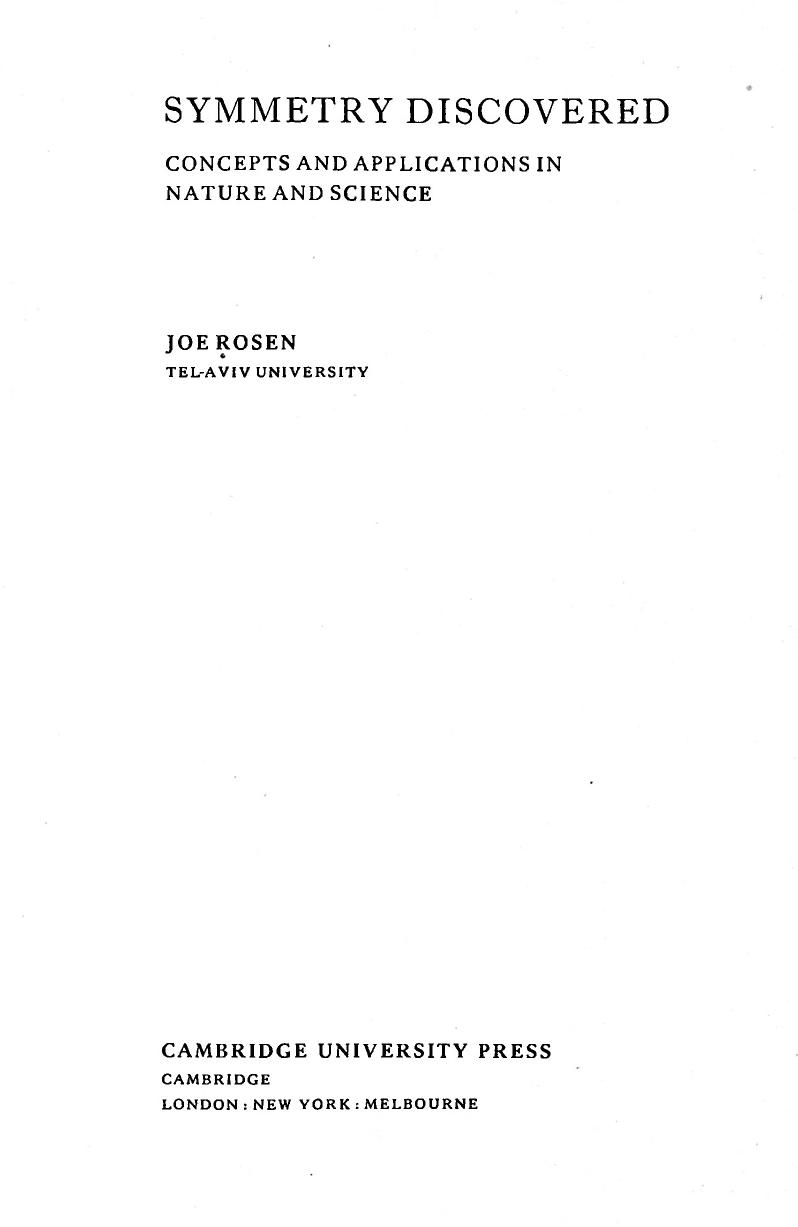Symmetry Discovered by Joe Rosen

Author:Joe Rosen [Rosen, Joe]
Language: eng
Format: epub, pdf
ISBN: 9780486145006
Publisher: Dover Publications
Published: 2012-10-05T16:00:00+00:00
Symmetries we have not yet studied
‘Here — we — are,’ said Rabbit very slowly and carefully, ‘all — of — us, and then, suddenly, we wake up one morning, and what do we find? We find a Strange Animal among us. An animal of whom we had never even heard before! An animal who carries her family about with her in her pocket!’
(A.A. Milne: Winnie-the-Pooh)
We now turn to symmetries of nature that have not been described in the preceding chapters. The first of these is connected with Albert Einstein’s special theory of relativity, which has already been mentioned in this chapter as being based in part on various symmetries of nature — homogeneity and isotropy of space and homogeneity of time. For the present discussion let us reformulate these symmetries in terms of two well-equipped experimental physicists out to check the laws of nature. Homogeneity of space means that, if the two physicists perform experiments at different locations but at the same time and with their apparatuses oriented in the same direction, they will find the same laws of nature. Isotropy of space implies that they will find the same laws of nature, if they perform their experiments at the same location and at the same time but with their apparatuses oriented differently. Homogeneity of time states that, if the two physicists check the laws of nature at the same location and orientation but at different times (actually a single physicist could do this), they will also find the same laws of nature.
In all these cases it is tacitly assumed that both physicists are at rest. The most important of the basic assumptions of special relativity has to do with physicists in relative motion. It claims that, if one physicist is at rest and the other moves at constant speed in a straight line, they will still find the same laws of nature. This can be formulated as a symmetry by stating that the laws of nature are invariant under changes of the constant straight-line velocity of the laboratory in which the laws are tested. These transformations are called velocity transformations or boosts. (Since we cannot devote an excessive amount of space to special relativity, we purposely refrain from discussing important details, such as: With respect to what are rest and constant straight-line velocity determined? How is invariance of laws of nature expressed?) One such law is the speed of light c = 299 793 kilometers per second, with the seemingly paradoxical result that every measuring device, whatever its velocity, will find this same value for c. Some of the better known correct predictions of the special theory of relativity are: the equivalence of mass m and energy E through Einstein’s famous relation E = mc2 ; the contraction of a body moving with velocity ν by the factor√(1 − ν2/c2 ); the slowing down of a clock moving with velocity v by the same factor; the impossibility of accelerating a body to velocities equaling or exceeding the speed of light.
Download
This site does not store any files on its server. We only index and link to content provided by other sites. Please contact the content providers to delete copyright contents if any and email us, we'll remove relevant links or contents immediately.
The Complete Stick Figure Physics Tutorials by Allen Sarah(7339)
Secrets of Antigravity Propulsion: Tesla, UFOs, and Classified Aerospace Technology by Ph.D. Paul A. Laviolette(5338)
Thing Explainer by Randall Munroe(3912)
The River of Consciousness by Oliver Sacks(3575)
The Order of Time by Carlo Rovelli(3164)
How To by Randall Munroe(3078)
A Brief History of Time by Stephen Hawking(2995)
I Live in the Future & Here's How It Works by Nick Bilton(2963)
What If?: Serious Scientific Answers to Absurd Hypothetical Questions by Randall Munroe(2675)
The Great Unknown by Marcus du Sautoy(2666)
Midnight in Chernobyl by Adam Higginbotham(2521)
Blockchain: Ultimate Step By Step Guide To Understanding Blockchain Technology, Bitcoin Creation, and the future of Money (Novice to Expert) by Keizer Söze(2469)
Networks: An Introduction by Newman Mark(2383)
The Meaning of it All by Richard Feynman(2320)
Easy Electronics by Charles Platt(2310)
The Tao of Physics by Fritjof Capra(2247)
Midnight in Chernobyl: The Untold Story of the World's Greatest Nuclear Disaster by Adam Higginbotham(2200)
Introducing Relativity by Bruce Bassett(2098)
When by Daniel H Pink(2098)
